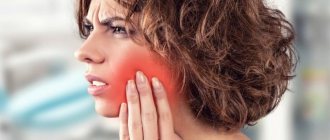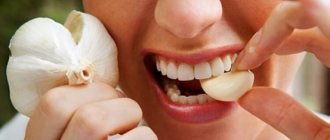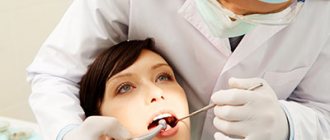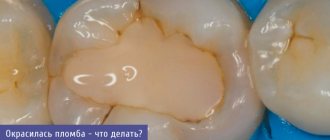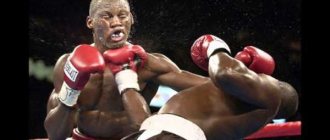A tooth bruise is a common injury that can go virtually unnoticed or lead to serious complications. This is due to the fact that after a blow, the position of the tooth does not change, and the periodontal tissue can suffer greatly. The consequences of a bruise depend on the force of impact. Significant damage can cause tooth loss. Since nerve endings and blood vessels are affected during a bruise, you should contact the dentist immediately, even if there are no external changes or painful sensations.
What it is
One of the most common dental injuries, mostly occurring in childhood, is bruising. Of course, this kind of damage cannot be ruled out in adults, especially those leading an active lifestyle and involved in traumatic sports.
A tooth bruise is a closed injury caused by strong mechanical impact with a hard object. In this case, the integrity of the bone tissue and the anatomical position are not damaged, but the periodontal tissues suffer, sometimes severe rupture occurs, followed by bleeding.
If the blow was so powerful that the neurovascular bundle was damaged, the tooth may become stained or darkened due to hemorrhage into the dentinal tubules and pulp tissue. Occasionally, with a bruise, numbness is one of the accompanying signs, as well as external damage to the facial area in the injured area, as well as the appearance of swelling and bruising. In any case, most often all these damages are reversible and can be treated if you consult a dentist in a timely manner.
Diagnosis of pathology in the dental office
If your tooth hurts or becomes numb after an impact, or if it has moved, you should immediately consult a dentist. The specialist will conduct an external examination and palpation. The doctor will also definitely send you for an X-ray examination to determine the condition of the tissues and their integrity, detect internal damage, and differentiate the bruise from other possible injuries (fracture, dislocation, crack). In order to check the condition of the pulp, to identify traumatic pulpitis and periodontitis, electroodontic diagnostics (EDD) can be performed.
Causes
Like any other injury, a tooth bruise can have a wide variety of causes. This could be an accidental hit in the jaw with a ball or other sports equipment, an unfortunate fall, a strong blow in a fight, or the consequence of a road accident or riding a bicycle. All these reasons have one thing in common - a strong blow of a mechanical nature.
Children and athletes are the most vulnerable to such injuries. It is these two categories of patients with a similar diagnosis that are the most frequent visitors to dental clinics. However, household injuries, as a result of which a person accidentally or recklessly hits a tooth, can cause a bruise. In this case, the most unprotected and weakest anterior and lateral incisors on the upper jaw most often suffer due to the anatomical structure and overhang of the upper jaw over the lower jaw.
Diagnosis and treatment of tooth dislocation
Using an x-ray and available clinical data, the type of injury received is revealed. In addition, it is possible to conduct a radiovisiographic study to study the condition of the alveolar bone and the position of the tooth. Treatment is prescribed according to the specific type of injury.
In case of incomplete dislocation, therapy is indicated to preserve the tooth. It is repositioned with fixation using mouthguards, wire splinting structures or splints. It is also recommended to take medications to prevent infection and the development of the inflammatory process. A repeat examination by a dentist is carried out a month later.
Endodontic treatment is indicated in case of pulp death.
In case of complete dislocation, prosthetics are necessary. Sometimes replantation is performed: the damaged tooth is returned to the socket, splints or splinting structures are used for healing.
Treatment of impacted dislocations involves several options:
- tooth extraction and its replacement with a prosthesis;
- tooth extraction with its replantation;
- immediate reposition of the tooth with its subsequent immobilization;
- long-term reduction.
Symptoms
The symptoms accompanying a tooth bruise are easy to recognize. If a person bruises a tooth, it hurts quite noticeably, and over time the pain only intensifies, especially with pressure on the damaged area and chewing food. The following symptoms are also present:
- When the neurovascular connection is ruptured, hemorrhage occurs into the pulp tissue, due to which the enamel quickly turns pink;
- The crown may darken;
- When bruised, the tooth becomes loose, although its mobility is relatively small;
- At the site of impact on the soft tissues of the gums, swelling, hyperemia, deformation of individual areas of the mucous membrane, and the formation of hematomas may occur;
- If there is a very strong impact, ligament rupture, joint damage, or even a fracture of the alveolar process of the jaw may occur where the striking object hits the jaw. In this case, it will be difficult and painful for the patient to open and close the jaw. Such damage can only be diagnosed with an x-ray.
We divide all dental injuries of children
- Bruise - characterized by only minor damage, a crack in the enamel, hemorrhages in the pulp chamber, swelling, or bruising on the gums may be observed.
- Subluxation - a damaged tooth is displaced, its ligamentous apparatus and neurovascular bundle are partially damaged, and tooth mobility is noted.
- Luxation - incomplete and complete - the tooth protrudes significantly from the dentition, barely maintaining connection with the socket, or even falls out of it. The integrity of the neurovascular bundle and ligamentous apparatus of the tooth is compromised.
- Fracture of the crown of the tooth.
- Tooth root fracture
Further in the article we will tell you how acute injury to baby teeth in children is characterized by an impact, how to recognize an injury to the front teeth, and how to treat any tooth injury in a child.
Consequences
Not a single injury for a person passes without a trace. Even if you managed to avoid obvious complications at the time of treatment, there is always a possibility of their occurrence in the future. For a tooth bruise, the consequences are also no exception. One of the most common complications is the gradual death of pulp tissue if the pulp was damaged by an impact, but during treatment, identifying its viability gave positive results. With necrosis, the nerve endings in the tooth cavity are damaged, which inevitably leads to inflammation.
Another most common consequence of a bruise is staining of the enamel. Most often, it occurs in a short time after injury, since fluid from damaged vessels enters the dentinal tubules and stains the walls. In addition, the enamel may simply darken due to a lack of nutrients supplied through damaged fibers and tissues.
More serious complications that arise over time are also possible. This may be the development of a cyst, periodontitis, or a stop in root development in children in both milk and permanent teeth.
Trauma to the front teeth in a child
The front teeth in children are most often injured. And while injury to other teeth may go unnoticed, injury to a child’s front teeth quickly attracts the attention of parents. An ordinary bruise, in which only a barely noticeable crack in the enamel can be visually seen, may not bother the child in any way. In some cases, there may be discomfort or pain during chewing, or mechanical stress, and slight swelling of the soft tissues.
It’s another matter if, as a result of an injury, a subluxation, dislocation, or even fracture of a tooth occurs. Then the injury to the child’s front teeth is primarily visually noticeable. In the case of subluxation or dislocation, parents may notice an atypical position of the tooth, its slight displacement relative to other teeth. In addition, with this type of injury to the front teeth, bleeding, swelling of the soft tissues, inflammation, severe pain, and mobility of the injured tooth will be noted.
Children often experience fractures of their front teeth. It will be characterized by a violation of the integrity of hard tissues, chipping of a part of the tooth, pain, bleeding, swelling of soft tissues, and hemorrhages in them.
Diagnostics
What action should you take if you or your child gets a tooth bruise? First of all, you need to contact a dental clinic as soon as possible. Using an X-ray, as well as after palpation and a thorough visual examination, the doctor will determine the extent of the damage resulting from the bruise, and will also draw up a detailed plan for further treatment.
When a tooth is bruised, diagnosis must certainly include, in addition to identifying obvious symptoms, an x-ray examination to exclude possible internal injuries, such as a fracture of the root or alveolar process. In addition, damage to the periodontal area, if present, will be visible in the image.
Also, over the course of several days, the doctor must monitor the condition of the pulp using electroodontodiagnosis. It helps to identify even the initial stages of necrosis and remove damaged tissues in time before they begin to become inflamed.
Clinical picture
First of all, the doctor conducts a visual examination of the bruised area to identify hidden injuries that cannot be identified by a person without medical education. For example, symptoms of dislocations or fractures may not appear immediately. Professional consultation allows you to begin timely treatment, if required.
To recognize a jaw bruise, it is important to pay attention to the following symptoms:
- severe pain in the place where the blow fell, intensifying when pressed;
- visual signs (eg, swelling, redness, abrasions, bruises);
- limitation of jaw mobility when yawning, talking, chewing;
- inflammation of the lymph nodes;
- general weakness.
Jaw bruises are less dangerous than more severe injuries, so recovery is usually quick.
The doctor may order an x-ray or computed tomography to establish an accurate diagnosis. These studies will assess the condition of the internal tissues of the affected area.
Treatment
In some cases, if the impact is not very strong, no treatment other than monitoring the condition of the damaged area is required. It is necessary to provide the affected tooth with long-term rest, apply cold compresses to reduce the bruise and relieve swelling. Solid food is completely excluded from the patient's diet for several days. Among other things, the doctor must observe the injured tooth for two to three months to avoid complications.
In children with baby teeth, it is possible to grind off the enamel on the cutting edge to remove the load from the damaged area; this action is not carried out on permanent teeth.
To eliminate the consequences resulting from a severe bruise, treatment should consist of a number of procedures:
- first of all, the damaged area is numbed with an anesthetic;
- if there is damage to the pulp sac, the doctor performs trephination, depulpation and thorough treatment of the dental cavity with disinfectants, after which the canals are sealed;
- if the neurovascular bundle has been damaged and the enamel has darkened or become stained, it is recommended to bleach permanent teeth using hydroperite, which will return the enamel to a more or less natural color;
- if necessary, the doctor can prescribe, in addition to complete rest, anti-inflammatory drugs and physiotherapy to help quickly eliminate the consequences of the injury.
Even if there is no severe pain after a blow to the jaw, it is recommended to visit a dentist to identify possible hidden injuries. This will help you maintain the health of your teeth for many years to come.
Splinting teeth
The method is aimed at strengthening the teeth in the gums and preventing their further loosening. The essence of the manipulation is to combine mobile units into one block with healthy ones using a special fixing structure. Splinting can be temporary ( up to 1-3 months
), long-term (
up to 1 year
), permanent. Tires are divided into:
- removable
– mouthguards, clasp dentures; - non-removable
- tape, fiberglass or aramid thread, crowns, pin inlays (intradental splints), cap splints.
An effective option is fiberglass splinting
, aesthetic nanomaterials or ceramics. A strong, translucent white tape or thread is fixed to the inner surface of the teeth using a light-curing composite. The material is biocompatible with the human body, does not absorb saliva, does not enter into chemical reactions, firmly adheres to the enamel, and reliably holds the units in the desired position.
With temporary splinting, the structure is fixed for several months. This option is used for mild forms of periodontitis, periodontitis, to consolidate the result of orthodontic correction or mobility caused by injury. A permanent splint is installed in the treatment of moderate periodontitis, the presence of voids in the row (removed or fallen units). The fixing structure is replaced with a new one every 4-5 years
, sometimes more often (according to indications).
Splinting clasp prosthesis
Clasp prosthesis
– metal base (arch) with plastic gum and artificial crowns. Since the design has an attachment for each dental unit, the prosthesis can replace several lost teeth while simultaneously splinting loose elements. This method is used in the treatment of pathologies of moderate severity, when in addition to movable units there are healthy ones that serve as support for the prosthesis.
Splinting with crowns
The teeth are depulped, the root canals are filled, ground, and crowns made of durable material (metal-ceramics, ceramics, etc.) “soldered” to each other are fixed on them. This method is characterized by high reliability and long service life. The elements under the crowns are firmly locked together and completely motionless.
